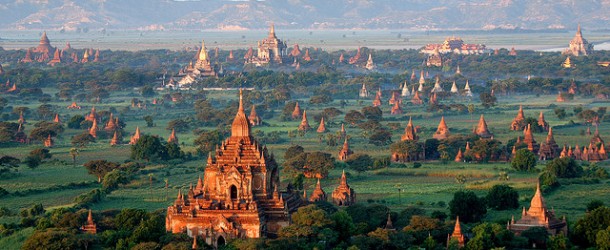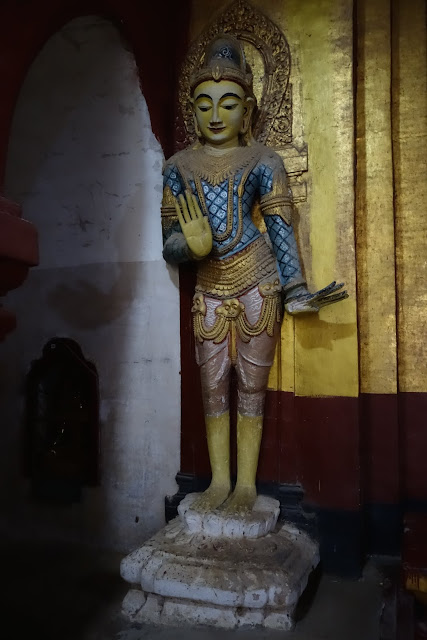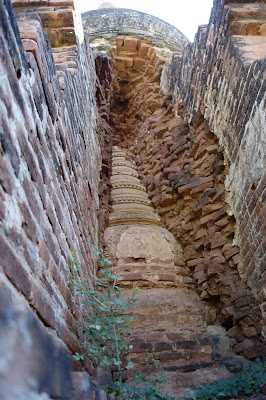
My Trip to Burma: Beautiful Breathtaking Bagan Part 1 – Fascinating Pagodas, Impressive Lacquerware, and an Amazing Sunset
 Vacation is supposed to be a time to relax. Well, not today. We set our alarm for 4:00 a.m., quickly got dressed, and checked out of our hotel in order to meet our driver and zip to the Yangon airport for our flight to Bagan.
Vacation is supposed to be a time to relax. Well, not today. We set our alarm for 4:00 a.m., quickly got dressed, and checked out of our hotel in order to meet our driver and zip to the Yangon airport for our flight to Bagan.
 You enter and find yourself in a dark foyer, with a very narrow staircase leading up to the second level. You have to let anyone on the second level know you’re coming up, because you can’t see if they’re coming down, and there’s no way you can pass each other on that stairway. When you get to the second level, you’re on a little terrace. The view from the terrace is indeed pretty impressive, the plain dotted with pagodas.
You enter and find yourself in a dark foyer, with a very narrow staircase leading up to the second level. You have to let anyone on the second level know you’re coming up, because you can’t see if they’re coming down, and there’s no way you can pass each other on that stairway. When you get to the second level, you’re on a little terrace. The view from the terrace is indeed pretty impressive, the plain dotted with pagodas.Temples, as far as the eye could see
Continuing our exploration of the really early temples, we passed by the Nathlaung Kyaung Temple just to the west of the Thatbinnyu. It’s the only remaining Hindu temple in Bagan. It’s one of the oldest temples in Bagan, built in the 11th century, built during the reign of King Anawratha, although some historians believe it was built in the 10th century during the reign of King Taungthugyi. Whatever. It’s freakin’ old. It was originally built for Hindu Burmese Indians of the 11th century, including merchants and Brahmins in the service of the king. The temple was closed, and we couldn’t go in, but we could peer into it from the outside. Many structures of the original temple have disappeared, although the main hall, which you see here, remains. Originally the temple contained statues of the 10 Avatars of Vishnu, including Gautama Buddha, however, only seven remain today. The brick temple was isolated and in disrepair for many years after it was damaged by earthquakes.
The temple is set on a square template with steeply rising upper terraces. As the oldest temple in Bagan, its style influenced and inspired the numerous other Buddhist structures that followed.
Nathlaung Kyaung means “Shrine Confining Nats or Spirits”, a reference to a purported time when King Anawratha tried to banish the worship of nats (spirits) in Bagan. (You’ll hear a LOT more about nats in future blog posts.) The King is said to have confiscated all non-Buddhist religious images including indigenous Myanmar nats and Hindu devas. Then he ordered them to be placed in this shrine as part of an effort to establish “pure” Theraveda Buddhism during his reign. Eventually the King gave in to the cult of the nats and he standardized the current line-up of Burmese nats by placing 37 chosen images at the Shwezigon Pagoda. In a few days, we’ll visit Mount Popa and see, in a little museum there, life-size depictions of those 37 nats. We couldn’t go in, but you can see, adorning the outside (and covered with gratings) Hindu images of the Buddha.
 Near the Thatbyinnyu pagoda and right up the road, really, from the Nathlaung Kyaung, there is another 10th century pagoda, the Ngakywenadaung pagoda, which features the bulbous shape favored by the Pyus. These cylindrical types of pagodas were found in the Sri Ksetra era. In fact, the oldest surviving stupas are those at the city of Sri Ksetra, where you can see many bulbous type stupas like this. (Unfortunately, this city is not on our itinerary.) Their cylindrical, elongated shape influence the forms of Bagan’s first pagodas. They slowly became more bell-like, with squat middle sections and tapering spires, and they grew higher and larger, set on grand stepped terraces, as you’ll see in the next few days. The Pahtothamya Temple (our next visit) also has a stupa shaped like this. As you can see, it’s kinda small. Hard to believe this little thing has such a rich history.
Near the Thatbyinnyu pagoda and right up the road, really, from the Nathlaung Kyaung, there is another 10th century pagoda, the Ngakywenadaung pagoda, which features the bulbous shape favored by the Pyus. These cylindrical types of pagodas were found in the Sri Ksetra era. In fact, the oldest surviving stupas are those at the city of Sri Ksetra, where you can see many bulbous type stupas like this. (Unfortunately, this city is not on our itinerary.) Their cylindrical, elongated shape influence the forms of Bagan’s first pagodas. They slowly became more bell-like, with squat middle sections and tapering spires, and they grew higher and larger, set on grand stepped terraces, as you’ll see in the next few days. The Pahtothamya Temple (our next visit) also has a stupa shaped like this. As you can see, it’s kinda small. Hard to believe this little thing has such a rich history.
The Ngakywenadaung pagoda was donated by King Taungthugyi during the 10th century. It’s 13-meters high. It used to be covered with green glazed tiles, and many of them remain and can be seen. (There are four monuments in Bagan that are or were covered in green glazed tiles, and this is one of them. We’ll see one or two more in a few days.)
 A short stroll away was the Pahtothamya Paya. It dates back to the 10th or 11th century. It is a low-set, heavy structure in classic early-period style. The stupa is nothing amazing; it’s typical of the city’s oldest temples.
A short stroll away was the Pahtothamya Paya. It dates back to the 10th or 11th century. It is a low-set, heavy structure in classic early-period style. The stupa is nothing amazing; it’s typical of the city’s oldest temples. The entrance to the interior is through an arched antechamber.
The entrance to the interior is through an arched antechamber.
 This strategically placed little window is responsible for the light coming in to be focused on the Buddha’s face and body.
This strategically placed little window is responsible for the light coming in to be focused on the Buddha’s face and body. What really struck me about all of this was how unguarded it all was. Here we were, just the three of us, in a pagoda built over 1000 years ago, completely by ourselves. No admission fee, no video cameras, no alarms, no security guards. Nothing in glass cases or behind plexiglass screens. I mean, here I am, staring at and touching a marble statue that is hundreds of years old, unsupervised. This is why I’m so glad I came here now, while this is all still possible. Because once tourism gets really crazy (and it will), I fear that none of this will be possible. So go now!
What really struck me about all of this was how unguarded it all was. Here we were, just the three of us, in a pagoda built over 1000 years ago, completely by ourselves. No admission fee, no video cameras, no alarms, no security guards. Nothing in glass cases or behind plexiglass screens. I mean, here I am, staring at and touching a marble statue that is hundreds of years old, unsupervised. This is why I’m so glad I came here now, while this is all still possible. Because once tourism gets really crazy (and it will), I fear that none of this will be possible. So go now!Next stop: the Ananda Pahto. The Ananda is one of the most stylistically refined and impressive temples in Bagan, and the most revered by Burmese Buddhists. It was built around 1105 by King Kyanzittha, heralding the stylistic conclusion of the Early Bagan period and the beginning of the Middle Period.
It is considered the masterpiece of early-period Bagan architecture, a surviving masterpiece of Mon architecture. Probably the finest, largest, and best preserved temple in Bagan. During the 1975 earthquake, the Ananda suffered considerable damage, but it has since been totally restored.
The corn-cob looking stupa, soaring 170 feet, underlines the fact that the shrine was designed by Indian architects. It is crowned by a gleaming golden umbrella filial, called a hti. In 1990, on the 900th anniversary of the temple’s construction, the temple spires were gilded. You can see two of the gilded spires in the picture above.
The exterior base is embellished with bands of green glazed terra-cotta plaques (554 of them) showing scenes from the Jatakas, episodes of the Buddha’s life, derived from Mon texts.
There’s some pretty impressive stucco work along the rooftop
From time to time, the temple’s exterior is whitewashed, making sure the place is always gleaming.
Door guardians, made of exquisitely carved and painted hardwood flank the entrances on the east and west.
 The eastern Buddha, with arms by its side and hands outstretched, is off in that it doesn’t conform to any recognized mudra. Between its fingertips is said to be herbal pill, perhaps symbolizing the cure from suffering offered by the Buddha’s teachings. Or it could just be a Tylenol. It is also not an original.
The eastern Buddha, with arms by its side and hands outstretched, is off in that it doesn’t conform to any recognized mudra. Between its fingertips is said to be herbal pill, perhaps symbolizing the cure from suffering offered by the Buddha’s teachings. Or it could just be a Tylenol. It is also not an original. 
 Our guide pointed out something very cool. If you stand right at the base of the south-facing Buddha, he looks stern. If you step back a few meters, however, he’s smiling. Pretty neat!
Our guide pointed out something very cool. If you stand right at the base of the south-facing Buddha, he looks stern. If you step back a few meters, however, he’s smiling. Pretty neat!
Actually, we arrived at the entryway to the Sulamani. You come upon an area where vendors are selling all sorts of souvenirs.
Then you head through an arched entryway….
…and there up ahead is the majestic Sulamani. It was built in 1183 by King Narapatisithu. It’s not the biggest or the tallest, but many people think it’s the most beautiful of all Bagan’s monuments. The name Sulamani means “Crowning Jewel” or “Small Ruby”. One of the leading modern authorities on the Bagan archaeological plain, Paul Strachan, calls it “the grandiloquent gesture of an empire at its meridian”. It’s a double-cube structure, with two stories of equal height, each topped by three terraces to create a pyramid effect. It strikes a nice balance between the horizontal planes of the Early period with the vertical lines of the Middle period. The shikhara (the tower above the sanctuary) above is a reconstruction following the 1975 earthquake.
The Sulamani was actually more than a temple. The complex originally contained a large number of associated buildings, including an ordination hall, cells for the monks, and a library.
The exterior has fine plasterwork and unusual green and yellow glazed decorative tiles. Only the first floor is open to the public.
 Each of the four major levels has inner ambulatories running along the perimeter, with niches for Buddhas.
Each of the four major levels has inner ambulatories running along the perimeter, with niches for Buddhas.The place was beautiful. They had fermented tea leaf salad on the menu. This is a uniquely Burmese dish that we had tried a few times already. This version was really spectacular. The sauce that it came with was a big factor. I don’t know what they put in the sauce, but man oh man, it was fantastic.
We relaxed in our hotel room for about two hours, and then Myint came back to get us and take us to a lacquerware workshop. Myanmar has been a center for fine lacquerware since 1563. Bagan became the industry’s main hub in the 20th century, and in the 1920’s, the British founded a lacquerware school to foster the craft. Lacquerware can be expensive, because it can take a few months to complete even a small bowl. A large object with elaborate designs can take up to a year of work. It goes in stages, from the weaving of bamboo and rattan frames, through the molding and drying of the lacquer putty, to the careful engraving and polishing required to finish the pieces. The finer the detail and the more colors and layers of lacquer that are applied (15 coats is typical for a high-quality piece), the more it will cost.
 The owner, a very jovial guy sporting a huge mustache, was a real character. I’m sure he’s given tours of his workshop hundreds of times, and yet, even though it was just me and Mark visiting, he explained the entire process of lacquerware production with pride and enthusiasm. He has many children, nephews and nieces, and quite a few of them work at his factory.
The owner, a very jovial guy sporting a huge mustache, was a real character. I’m sure he’s given tours of his workshop hundreds of times, and yet, even though it was just me and Mark visiting, he explained the entire process of lacquerware production with pride and enthusiasm. He has many children, nephews and nieces, and quite a few of them work at his factory.
He also was telling us how he went to a conference to represent Burma’s lacquerware industry and he met President Obama there. He was very proud of that photo.
We left our shoes at the bottom (like you have to do at all pagodas), and raced on up.
We got to the terrace. There were maybe 15 people up there. Lots of space for us to get situated. The view was pretty wonderful, with the whole archaeological plain spread out in front of us.
What can I say? Let the sunset photos begin:
It was so peaceful and serene. Everyone was just chilling and relaxing before, during, and after. These Buddhist nations really have the relaxing thing all figured out.
Back to the hotel for dinner. Unfortunately, unless you have some sort of vehicle, the only dining options you have are at the hotel. We could have called a cab, but we were decided to just eat at the hotel restaurant. It was a little expensive (by that, I mean still really cheap), but we didn’t care. We had barely spent any money at all. They had some western dishes on the menu, and after a day of Burmese fare, I was ready for some good ol’ pizza. The restaurant overlooked the Ayeyarwaddy, although it was dusk and you couldn’t see the river. But the grounds were lovely and there was nice mellow entertainment – a guy playing some traditional Burmese type of xylophone, accompanied by a young girl singing – and a woman who manipulated a marionette while some recorded songs played over the speaker system. A nice way to end a great day. Tomorrow should be exceptional: we start with a hot air balloon ride over the plain. Can’t wait!











































